|
 Secure Site
Secure Site
|
 |
Archive for the 'mindfulness practice' Category
 the beauty of imperfection Wabi and sabi refers to a mindful approach to everyday life. Over time their meanings overlapped and converged until they are unified into Wabi-sabi, the aesthetic defined as the beauty of things “imperfect, impermanent, and incomplete”.
Things in bud, or things in decay, as it were, are more evocative of wabi-sabi than things in full bloom because they suggest the transience of things. As things come and go, they show signs of their coming or going and these signs are considered to be beautiful.
In this, beauty is an altered state of consciousness and can be seen in the mundane and simple. The signatures of nature can be so subtle that it takes a quiet mind and a cultivated eye to discern them. In Zen philosophy there are seven aesthetic principles for achieving Wabi-Sabi.
Fukinsei: asymmetry, irregularity
Kanso: simplicity
Koko: basic, weathered
Shizen: without pretense, natural
Yugen: subtly profound grace, not obvious
Datsuzoku: unbounded by convention, free
Seijaku: tranquility
Each of these things are found in nature but can suggest virtues of human character and appropriateness of behaviour. This, in turn suggests that virtue and civility can be instilled through an appreciation of, and practice in, the arts. Hence, aesthetic ideals have an ethical connotation and pervades much of the Japanese culture.
adapted from wikipedia.org
 Zen Alarm Clock, Ukiyo-e Hokusai Wave Dial Face Now & Zen Headquarter Store
1638 Pearl Street
Boulder, CO 80302
(800) 779-6383
Posted in Bamboo Chime Clocks, Chime Alarm Clocks, Hokusai Wave, Japanese Inspired Zen Clocks, mindfulness practice, Natural Awakening, Now & Zen Alarm Clocks, Progressive Awakening, wabi-sabi
 Iris Bath by Utagawa Toyohara, Ukiyo-e Print
Compassion is that which makes the heart of the good move at the pain of others. It crushes and destroys the pain of others; thus, it is called compassion. It is called compassion because it shelters and embraces the distressed.
– The Buddha.
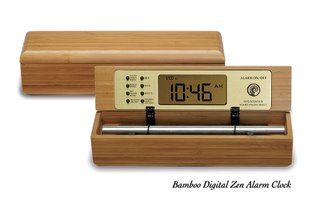 Bamboo Digital Chime Clock, a meditation timer and alarm clock Now & Zen
1638 Pearl Street
Boulder, CO 80302
Posted in Bamboo Chime Clocks, Japanese Inspired Zen Clocks, Meditation Tools, mindfulness practice, Now & Zen Alarm Clocks, Progressive Awakening, Well-being
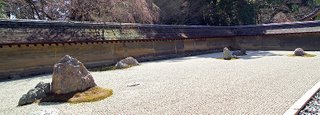 Stone garden in the karesansui style at Ryōan-ji. Karesansui Gardens or “dry landscape” gardens were influenced mainly by Zen Buddhism and can be found at Zen temples of meditation.
In Japanese culture, garden-making is a high art, intimately related to the linked arts of calligraphy and ink painting.
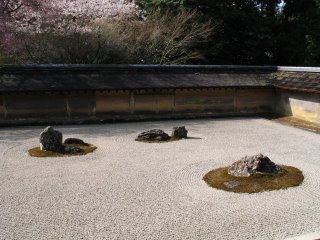 Ryōan-ji Unlike other traditional gardens, there is no water present in Karesansui gardens. However, there is raked gravel or sand that simulates the feeling of water.
The rocks/gravel used are chosen for their artistic shapes, and mosses as well as small shrubs are used to further garnish the Karesansui style (Japanese Lifestyle).
All in all, the rocks and moss are used to represent ponds, islands, boats, seas, rivers, and mountains in an abstract way. Ryoan-ji, temple in Kyoto, has a garden famous for representing this style. Daisen-in, created in 1513, is also particularly renowned.
adapted from wikipedia.org
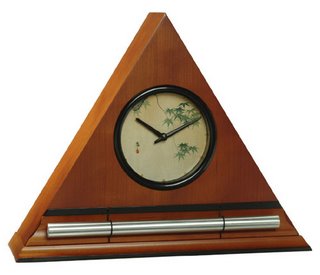 Zen Clocks by Now & Zen, Boulder, CO Now & Zen
1638 Pearl Street
Boulder, CO 80302
(800) 779-6383
Posted in Chime Alarm Clocks, mindfulness practice, Natural Awakening, Now & Zen Alarm Clocks, Zen Clocks and Dream Recall, Zen Timers
 Snow print by Suzuki Harunobu - Life Your Mood to Change Your Life Research in cognitive psychology shows that our thoughts determine the quality of our emotions, moods, actions, and life experiences. “So nothing is more urgent or more important than learning how to take charge of our thinking,” says Selby. He created a technique to break “thought addiction,” or an inability to let go of past regrets and future worries in order to enjoy the present moment.
The approach uses “cognitive shifting,” which helps you move between states of mind and optimize your mental performance. In pairing that mental shift with specific phrases you say to yourself, you build a powerful habit that can overcome the tendency to “read” events in a negative way. In short: You stop letting little things upend entire days.
Wake up with gradual, beautiful acoustic chimes. The Zen Alarm Clock transforms your mornings and gets you started right, with a progressive awakening.
 Waking up in the morning should be as pleasant as falling asleep at night. The Zen Alarm Clock's gradual, gentle awakening is transformative.
Boulder, Colorado—an innovative company has taken one of life’s most unpleasant experiences (being startled awake by your alarm clock early Monday morning), and transformed it into something to actually look forward to. “The Zen Alarm Clock,” uses soothing acoustic chimes that awaken users gently and gradually, making waking up a real pleasure.
Rather than an artificial recorded sound played through a speaker, the Zen Clock features an alloy chime bar similar to a wind chime. When the clock’s alarm is triggered, its chime produces a long-resonating, beautiful acoustic tone reminiscent of a temple gong. Then, as the ring tone gradually fades away, the clock remains silent until it automatically strikes again three minutes later. The frequency of the chime strikes gradually increase over ten-minutes, eventually striking every five seconds, so they are guaranteed to wake up even the heaviest sleeper. This gentle, ten-minute “progressive awakening” leaves users feeling less groggy, and even helps with dream recall.
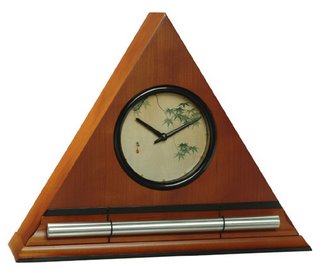 Calming Chime Alarm Clocks with Gentle Chimes Now & Zen’s Calming Chime Alarm Clock Store
1638 Pearl Street
Boulder, CO 80302
(800) 779-6383
Posted in Cherry Blossoms, Meditation Timers, Meditation Tools, mindfulness practice
 Sharaku Toshusai, The actor Matsumoto Yonesaburo as Shinobu - Stay Calm, Be Thankful Write a gratitude list. If your average day feels more like a triathlon, saying a quick thanks can help you stay calm. According to a study in the journal Integrative Physiological and Behavioral Science, people who were coached to be more appreciative experienced a 23 percent drop in their levels of the stress hormone cortisol after a month. Before you tackle your to-do list, take a moment to jot down one thing you’re grateful for today.
Try Meditating More Often:
Although meditation can be done in almost any context, practitioners usually employ a quiet, tranquil space, a meditation cushion or bench, and some kind of timing device to time the meditation session. Ideally, the more these accoutrements can be integrated the better. Thus, it is conducive to a satisfying meditation practice to have a timer or clock that is tranquil and beautiful.
Using a kitchen timer or beeper watch is less than ideal. And it was with these considerations in mind that we designed our digital Zen Alarm Clock and practice timer. This unique “Zen Clock” features a long-resonating acoustic chime that brings the meditation session to a gradual close, preserving the environment of stillness while also acting as an effective time signal.
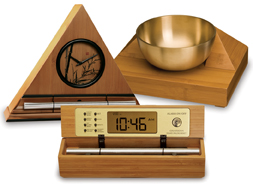 Time Your Meditation with a Gentle Bowl/Gong Timer from Now & Zen, Inc. Now & Zen’s Meditation Timer Store
1638 Pearl Street
Boulder, CO 80302
(800) 779-6383
Posted in Bamboo Chime Clocks, Chime Alarm Clocks, Meditation Timers, Meditation Tools, mindfulness practice, Well-being
 Choose a Gentle Zen Timer for Your Partner Yoga Practice Partnering up in yoga class can deepen your practice and connect you to yourself and your fellow yogis.
We were only a few minutes into the yoga class when the teacher uttered the five words I dread hearing: “OK, everybody, find a partner!” As we students sized up one another with varying degrees of wariness, the teacher demonstrated what she wanted us to do by leaping lightly onto the thighs of a supine volunteer and balancing there, as gracefully as a cat, her feet grounding and rotating her partner’s thighs inward.
Full disclosure: My approach to partnering exercises in yoga class has generally been of the “Lie back and think of England” variety, though I usually participate as gamely as I can. But this particular caper was just too much for my inner Woody Allen. What if my partner or I slipped and fell? What if I had bone density issues I didn’t know about? What if my partner outweighed me, or I her? What about my bad knee? Where were the feet supposed to go? Concerned about my safety, and uncomfortable turning to the person next to me and saying, “It’s nice to meet you. I’m now going to place my bare feet on your thighs,” I declined to participate.
Unlike “partner yoga,” in which two people come together to create a single pose, often practiced with a friend or significant other, “partnering” takes place when your teacher asks you to consider the student next to you as a human prop to help you get into a pose more fully, isolate a particular action, or help you balance. A teaching tool in many styles of yoga classes, partnering tends to inspire strong feelings among practitioners: Mention the subject to a group of yoga students, and the room is likely to erupt in exclamations as people tell their stories of awkward moments, contact with another person’s sweat or stinky feet, and even injuries.
 Dos damas paseando - artista Shunshô Katsukawa Here at the Yoga Journal office, where we practice yoga together every day, we ask that our teachers not do partnering exercises in class—not all of us are comfortable with the degree of physical intimacy involved in sharing sweat with a supervisor, or gripping a co-worker from behind. But the frequency of partnering exercises in the other classes I attended made me wonder whether my resistance to them could be holding me back. What was I missing by participating reluctantly, or opting out entirely? When I started asking around, I discovered that there’s no simple answer to that question, since partnering exercises themselves, and people’s attitudes toward them, vary greatly. A few teachers told me that they never teach partnering exercises in class, because of the risk of injury. For other teachers and practitioners, asking, “How do you feel about partnering?” was like asking, “How do you feel about yoga?”—so central does the one practice seem to be to the other. Still others described partnering, when done safely and skillfully, as a useful tool for deepening your practice.
Use our unique “Zen Clock” which functions as a Yoga Timer. It features a long-resonating acoustic chime that brings your meditation or yoga session to a gradual close, preserving the environment of stillness while also acting as an effective time signal. Our Yoga Timer & Clock can be programmed to chime at the end of the meditation or yoga session or periodically throughout the session as a kind of sonic yantra. The beauty and functionality of the Zen Clock/Timer makes it a meditation tool that can actually help you “make time” for meditation in your life. Bring yourself back to balance.
adapted from YogaJournal.com by Charity Ferreira
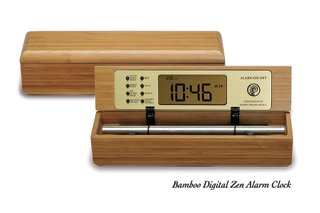 Yoga Timer for Partner Yoga in Bamboo Now & Zen’s Yoga Timer Store
1638 Pearl Street
Boulder, CO 80302
(800) 779-6383
Posted in Meditation Timers, Meditation Tools, mindfulness practice, Yoga Timer, Yoga Timers by Now & Zen
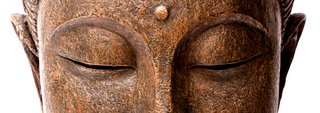 Buddha Meditation can be challenging. Even after you’ve had a taste of its benefits and long for those sweet moments of inner calm, clarity, and deep connection, it can be hard to just sit. If you’re like most people, you may find that one day your mind is speeding into the future, your body feels agitated, and you can’t sit still, while the next day you’re so lethargic that you can hardly stay awake. Don’t be discouraged. Resting with ease in meditation doesn’t magically happen. But there is a path to help you get there: Through your breath, you can tap into the flow ofprana (life force) to increase, decrease, or focus your energy, bringing you into a state of balance and making it easier to sit with relaxed attention in meditation.
Prana flows along energy channels in the body called nadis.The three main nadis are the sushumna, the central channel along the spine through whichkundalini, your spiritual energy, ascends; and the ida and pingala, which start on either side of the sushumna and spiral upward in a double-helix pattern around it.
Prana moves with breath and mind (which includes your thoughts, mental images, and emotions). A change in one affects the other. Through the breath, you can open, regulate, and direct the flow of prana, which, in turn, will stabilize the mind and body for meditation.
Depending on your mood and energy level, one of the following asana and pranayama practices can help you move from agitation to relaxation, from lethargy to lightness, from fragmentation to integration—so that you might ease gently into meditation. (To find a variety of meditation practices, click here.) The emphasis in each of the following practices is on linking slow, mindful movements with the breath and creating dynamic, flowing transitions to integrate mind and body. Each series is repeated several times, during which the length of the exhalation and inhalation—and the pauses in between—change progressively.
Sometimes you need to wake up, and sometimes you need to calm down. Often you need a combination of awakening, calming, and focusing energies. But to understand your needs, it’s essential to spend some time discovering what state your energy is in.
 Meditation - Choose a Gentle Tibetan Bell-like Gong for a Timer How Do You Feel?
Begin by lying on your back with your legs extended. Fill your body with awareness, as if you were filling a glass with water. Notice how your body responds. Does it begin to release and relax, or is there resistance? Close your eyes and feel the weight of your skull and pelvis, the contact of your back on the floor. Are there places that pull away from the floor and areas that are more in contact?
Then mentally scan your body one area at a time. Begin with your toes and travel up to your legs, pelvis, spine, lower and upper back, and shoulders, then down your arms and hands, and back up your arms to your neck and head. Are there areas of discomfort, places that feel stiff or more spacious, or parts that feel warm, cold, or numb? Some areas of holding are so habitual that we skip over them without noticing; let your attention gently tap into those places. As you scan your body, see whether a running commentary is going on in your head. Try not to judge or analyze what you discover. Instead, simply notice what is present. Now bring your focus to the central column of your spine. Imagine a wide river from the base of your spine to the base of your skull. Does the river flow freely? Are there areas where it’s blocked, narrowed, or stagnated?
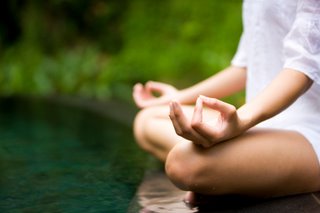 Meditation for Relaxation Next, bring your awareness to your entire body at once. Notice if there are any strong sensations remaining, areas of the body calling for attention. Now allow your mind to draw into the breath. Notice the quality, texture, and rhythm of your breathing. Is it short and choppy, long and smooth, or somewhere in between? Do you tend to hold your breath after breathing in or out? Notice the relationship between your breath, body, and thoughts.
Now check out the flow of thoughts moving through your mind. Do you have a perpetual to-do list? Are you rehashing some conversation or planning the future? Are you spacing out, or do you feel sharp and clear? Try not to make judgments—simply observe. As certain thoughts come, is there a physical response in your body or your breath?
Next, place one hand on your heart. Take a moment to feel the beating of your physical heart, your chest rising and falling with your breath. Let your awareness settle into its rhythm, then drop your attention in a little deeper, sensing the emotional heart. Is there sadness, joy, or anxiety? Don’t go deeply into any one feeling; just get a sense of the overall tone that is present at this moment. Make note of the relationship between your emotional state and your breath, between your feelings and your physical body.
Finally, feel all of these dimensions at once: physical, energetic, mental, and emotional. Notice the part of you that is observing—your unchanging awareness. Now rest in this spacious awareness.
Remember, your observations may change from day to day, depending on the hour, your schedule, and all of the other variables that affect your energy and mood. If you observed that your breathing was labored, your mind dull, and your heart heavy, try an energizing practice. Was your breathing rapid, your mind racing, and your body tense? Then a calming practice might be most appropriate. Feeling scattered and disoriented? A focusing practice can help you come into balance. Listen to your mind, body, and heart for guidance about a movement practice that can bring you into balance, ready to sit and draw your attention inward.
Use our unique “Zen Clock” which functions as a Yoga and Meditation Timer. It features a long-resonating acoustic chime that brings your meditation or yoga session to a gradual close, preserving the environment of stillness while also acting as an effective time signal. Our Yoga Timer & Clock can be programmed to chime at the end of the meditation or yoga session or periodically throughout the session as a kind of sonic yantra. The beauty and functionality of the Zen Clock/Timer makes it a meditation tool that can actually help you “make time” for meditation in your life. Bring yourself back to balance.
adapted from YogaJournal.com by Janice Gates
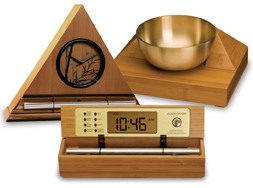 Gong Timer for Meditation Now & Zen’s Gong Timer Store
1638 Pearl Street
Boulder, CO 80302
(800) 779-6383
Posted in Meditation Timers, Meditation Tools, mindfulness practice, Natural Awakening
 Buddha Set aside half an hour.
Begin by calling to mind a sage or saint, or another human being you deeply admire. It should be someone you have a feeling for and whose teachings you understand—Jesus, or Buddha, Gandhi, St. Teresa of Avila, the Baal Shem Tov, or your own teacher, if that teacher has been a reliable example of enlightenment.
If no one comes to mind, choose one of the qualities of enlightened consciousness—such as compassion or love. Now, think deeply about that person or the quality you want to embody. Consider how it might be to look through that person’s eyes. If it’s a quality, ask yourself, “How would it be at this moment to look through the eyes of love?” Ask yourself, “How did this being treat others?” How might he or she behave while living your life? (Yes, what would Jesus do?) Imagine facing a challenge, a big conflict, the desertion of someone close. How would that person handle it?
Now, close your eyes and imagine that the spirit of that person (or that quality) inhabits your body. Inhale, thinking to yourself, “Christ’s love lives within me, as my love,” or “Buddha’s state of enlightenment is my enlightenment,” or “The courage of Gandhi is my courage.” Exhale, thinking, “That inner state fills my body.”
Do this for a few moments. Then ask yourself, “How would I move through the world if I truly embodied the qualities of this being? How would I treat myself? How would I be with my partner? my kids? my parents? the people on the bus? What would it be like to interact with others?”
Let your imagination completely open to this practice, imagining yourself enlightened, saturated with love. For the remainder of the half hour, act out of that experience. Be the great being you’re imagining yourself to be. Act out the quality you want to imbibe. Do this for half an hour a day for a week and see if you notice the effect.
Although meditation can be done in almost any context, practitioners usually employ a quiet, tranquil space, a meditation cushion or bench, and some kind of timing device to time the meditation session. Ideally, the more these accoutrements can be integrated the better. Thus, it is conducive to a satisfying meditation practice to have a timer or clock that is tranquil and beautiful. Using a kitchen timer or beeper watch is less than ideal. And it was with these considerations in mind that we designed our digital Zen Alarm Clock and practice timer. This unique “Zen Clock” features a long-resonating acoustic chime that brings the meditation session to a gradual close, preserving the environment of stillness while also acting as an effective time signal. The Digital Zen Clock can be programmed to chime at the end of the meditation session or periodically throughout the session as a kind of sonic yantra. The beauty and functionality of the Zen Clock/Timer makes it a meditation tool that can actually help you “make time” for meditation in your life.
adapted from YogaJournal.com by Sally Kempton
 Zen Gong Alarm Clock and Timer for Meditation and Yoga Now & Zen’s Gong Meditation Timer
1638 Pearl Street
Boulder, CO 80302
(800) 779-6383
Posted in Chime Alarm Clocks, Meditation Timers, Meditation Tools, mindfulness practice
 Meditation Timers & Clocks - Utgawa I’m not exactly clear on how they did it. Something about taking Group No. 1 over here, hooking them up to a nifty array of happyfun electrodes and letting them begin their deep and experienced meditation practice, and then, at some point, suddenly blasting the sound of a woman screaming in distress right into their prefrontal lobes like a swell little ice pick of terror.
And then the researchers observed which parts of the meditators’ brains lit up and noted that it was the hunks related to empathy and compassion and also the parts that say, “Hey, that screaming can’t be good, and I think I’ll get up and go help that poor woman.”
Then they did a similar thing with Group No. 2, only minus most of the experienced meditation part. And when this group heard the same woman screaming in distress, their brains also lit up, only this time it was those parts that said, “Huh, chick screaming in distress, let us now reach for the remote control and turn up the volume on this delightful episode of ‘How I Met Your Mother’ to drown out that obnoxious sound, because, you know, how annoying, and, by the way, I could really use a Bud Light and some guns right about now.”
It’s not exactly news
I might be oversimplifying. Or exaggerating. No matter, because the fact remains it is was one of those nice studies that deigns to reveal a helpful factoid that millions of people, and thousands of teachers and gurus and healers, have known for roughly a billion years.
It is this: Deep meditation, the act of stilling yourself and calming the mind and working with the breath and maybe reciting a mantra or clearing your chakras or running a nice bolt of golden energy up and down your spine, can have a positive effect on your worldview, can inject some divine love juice into your core and make you more sympathetic, kinder, more apt to feel a natural inclination toward generosity and compassion and helping people who might be, you know, screaming.
I know. Totally shocking.
It’s a small study that goes handily with the umpteen similar bits of research recently, all of which seem to indicate some other famously healthful aspect of meditation: stress relief, illness prevention, life extension, emotional stability, improved sleep, increased productivity, better orgasms, fewer ingrown hairs, brighter sunshine, better gas mileage and also merely learning to sit still and shut up once in a while, which I can promise you will make your wife and your siblings and your kids and your dog and even your own squealing manic ego very happy indeed.
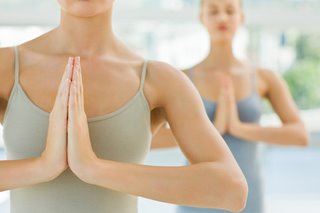 Meditation Timers and Alarm Clocks with Soothing Chimes Did you already know of such benefits? I’m guessing you did. Here in NorCal, meditation is so widespread and normalized it’s available in the Whole Foods bulk aisle. I do believe over in Berkeley and parts of Marin County you are actually required by law to meditate at least twice a week atop your handmade zazen cushion in your Zen rock garden next to your carefully restored BMW 2002 as you listen to very cheesy wind chime music on an iPod-enabled Bang & Olufsen 5.1 home theater system just before you pour yourself a nice glass of Sonoma Chard, or the police come and politely take away your Tibetan Nag Champa incense holder for a month.
Just a froufrou thing
Ah, but I suppose this is not the case nationwide. I imagine the practice is still widely considered, even after all these millennia and all these studies and teachers and perky New Age bookstores and all the obvious proof that meditating has little, really, to do with religious belief, to be some sort of hippie cultish pagan anti-Christian satanic froufrou thing more aligned with monks and bells and Hindu wackiness than with everyday gul-dang gun-smokin’ ‘Merkin life.
And hence I guess we still need studies like this to lend validation to a timeless wisdom that, if disseminated more widely, could improve the health of the nation. Hey, every little bit helps, right? Enough studies and enough serious medical journals bring alternative ideas like meditation to the fore and maybe, just maybe, we could nudge the culture away from mania and obsession and road rage and a zillion Prozac prescriptions as the only means of coping with the trudging maelstrom of daily existence.
It can’t hurt. Because the problem is that we as a culture are still very much trained, beaten, shaped from birth to never, ever, no matter what you do, calm down and breathe more consciously and try to live more fully in the moment you are in. Present-time awareness? Breathwork? Cultivating a sense of loving kindness? Save it for the New Age Expo, hippie. Real men live in some neurotic-psychotic state of need and regret and wishful thinking, all undercut with a constant shiver of never-ending dread. Isn’t that right, Mr. President?
But meditation, well, it abides none of that noise. It brings you into the here and now and plops you into the lap of stillness and reminds you that there is more to it all, that you have incredible power to change your own habits and tendencies and daily love quotients, that God often speaks in whispers and flutters and quiet little licks on your heart and only when you dial down your raging internal dialogue can you actually hear what she’s trying to say. What’s not to like?
Of course, you need no scientific study to learn any of this for yourself. But who knows, maybe there will come a day when you can stroll into just about any doctor’s office and she will say, what’s that? You say you’re getting weird rashes and heart palpitations and you feel overwhelmed? You have rage issues? Melodrama? Warmongering and pain and fear of the Other? Have a glass of wine. Eat better. Exercise. More sex, less whining, better books.
And oh yes, also this: Once a day, just for a few minutes, go sit very still, close your eyes, shut up and breathe.
Use our unique “Zen Clock” which functions as a Yoga & Meditation Timer. It features a long-resonating acoustic chime that brings your meditation or yoga session to a gradual close, preserving the environment of stillness while also acting as an effective time signal. Our Yoga Timer & Clock can be programmed to chime at the end of the meditation or yoga session or periodically throughout the session as a kind of sonic yantra. The beauty and functionality of the Zen Clock/Timer makes it a meditation tool that can actually help you “make time” for meditation in your life. Bring yourself back to balance.
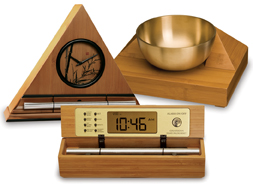 Meditation Timers and Clocks -- From Now & Zen adapted from SFgate.com by Mark Morford columns with inset links to related material can be found at sfgate.com/columnists/morford.
Now & Zen – The Zen Timer and Alarm Clock Store
1638 Pearl Street
Boulder, CO 80302
(800) 779-6383
Posted in Bamboo Chime Clocks, Meditation Timers, Meditation Tools, mindfulness practice, Yoga Timer, Zen Timers
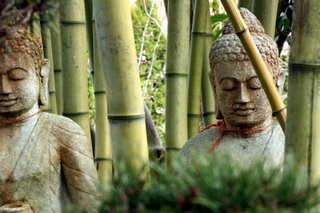 creating sacred spaces Meditation and other spiritual practices are basic to enhancing energy—they create balance and improve the quality of your home or office. In fact, the best thing you can do to create a sacred santuary (to improve the supportiveness of a space) is to do spiritual practices (sadhana). Prayer, meditation, yoga, chanting, and pranayama all enliven a space.
Be consistent with the spiritual practices of whatever tradition you are drawn to. As the Sufi poet Rumi said, your true home is within and reachable by letting go and allowing the mind to go inward. When we feel at home within ourselves and within our own hearts, any building we live in will feel more serene and supportive. Meditation practices make us more perceptive of our environment, so that we intuitively know many of the changes to make. We become more in touch, literally and metaphorically. According to Vastu, the northeast or the center of the home is the best area for meditation rooms, spiritual altars, and yogic practices.
adapted from Yoga Internation by Sherri Silverman
Use our unique “Zen Clock” which functions as a Yoga & Meditation Timer. It features a long-resonating acoustic chime that brings your meditation or yoga session to a gradual close, preserving the environment of stillness while also acting as an effective time signal. Our Yoga Timer & Clock can be programmed to chime at the end of the meditation or yoga session or periodically throughout the session as a kind of sonic yantra. The beauty and functionality of the Zen Clock/Timer makes it a meditation tool that can actually help you “make time” for meditation in your life. Bring yourself back to balance.
 tools for meditation, zen timer Now & Zen – The Yoga Timer & Clock Store
1638 Pearl Street
Boulder, CO 80302
(800) 779-6383
Posted in Feng Shui, Meditation Timers, Meditation Tools, mindfulness practice, Well-being
« Previous Page — « Previous Entries
Next Entries » — Next Page »
|
|
|
|